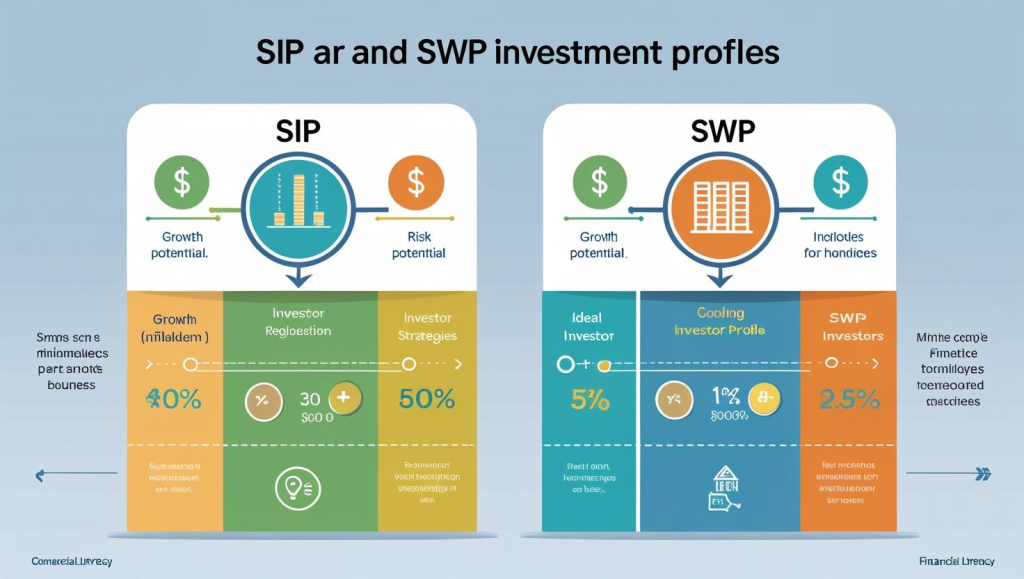
Introduction: Why SIP and SWP Matter in Personal Finance
In modern financial planning, Systematic Investment Plans (SIP) and Systematic Withdrawal Plans (SWP) have become cornerstones for investors at every life stage. Whether you’re starting your career or planning your retirement, understanding these tools can shape your financial journey.
This guide explains:
- How to start SIP and SWP
- Who should use them
- Differences, taxation, and real-life strategies
- SIP vs SWP: Which Is Better for Your Financial Goals?
- Who Should Choose SIP and Who Should Go for SWP?
- The Pros and Cons of SIP and SWP: What You Need to Know Before Investing
- Key Differences Between SIP and SWP Explained with Real-life Examples
- How to Build Wealth with SIP and Enjoy It with SWP
- SIP vs SWP Taxation: Which One Saves You More?
- Can You Do Both SIP and SWP? Here’s Why Many Investors Do
- SIP vs SWP: Which One Is Better During Market Volatility?
Knowledge of SIP and SWP isn’t just useful for investors — it’s also part of what you learn in a Executive pg diploma in finance, pgdm finance management, and pg diploma course in financial services. Let’s explore why.
 What Are SIP and SWP?
What Are SIP and SWP?
 SIP (Systematic Investment Plan)
SIP (Systematic Investment Plan)
A disciplined way to invest a fixed amount (e.g., ₹1,000–₹10,000) every month into mutual funds. It uses rupee cost averaging: buying more units when prices fall and fewer when prices rise.
 SWP (Systematic Withdrawal Plan)
SWP (Systematic Withdrawal Plan)
A method to withdraw a fixed amount (e.g., ₹10,000 per month) from your mutual fund investment, turning your accumulated corpus into regular income — ideal for retirement or predictable cash flow.
These are practical tools covered in post graduate diploma in finance distance learning programs.
 Step-by-Step Guide to Starting SIP
Step-by-Step Guide to Starting SIP
 Step 1: Define Your Goal
Step 1: Define Your Goal
Decide what you’re investing for:
- Retirement corpus
- Child’s education
- Buying a house
Set your investment horizon: 5, 10, or 20 years.
 Step 2: Choose Your Fund
Step 2: Choose Your Fund
- Long-term (10+ years): Equity mutual funds
- Medium-term (3–5 years): Balanced or hybrid funds
- Short-term: Debt funds
 Step 3: Decide Your Monthly Investment
Step 3: Decide Your Monthly Investment
Calculate backward from your goal amount using SIP calculators.
Example: To accumulate ₹50 lakh in 20 years at ~12% return, invest ~₹5,000 per month.
 Step 4: Register and Start SIP
Step 4: Register and Start SIP
- Use online apps, AMC websites, or banks.
- Complete KYC (PAN, Aadhaar).
- Choose amount, start date, and frequency (monthly is common).
 Step 5: Monitor Annually
Step 5: Monitor Annually
Review performance, but avoid frequent changes. SIP benefits from staying invested during market ups and downs.
 Step-by-Step Guide to Starting SWP
Step-by-Step Guide to Starting SWP
 Step 1: Build a Corpus
Step 1: Build a Corpus
Start with a sizable fund, often created through years of SIPs.
Example: ₹50 lakh corpus.
 Step 2: Decide Withdrawal Amount and Frequency
Step 2: Decide Withdrawal Amount and Frequency
- Typically monthly (e.g., ₹20,000).
- Choose based on your expenses.
 Step 3: Choose the Fund to Withdraw From
Step 3: Choose the Fund to Withdraw From
- Debt funds or conservative hybrid funds are recommended.
- Avoid highly volatile equity funds for SWP.
 Step 4: Register SWP
Step 4: Register SWP
- Fill SWP form via AMC or online portal.
- Specify withdrawal amount, frequency, and start date.
 Step 5: Monitor Corpus and Adjust
Step 5: Monitor Corpus and Adjust
If markets underperform or your needs change, adjust the withdrawal amount.
 1. SIP vs SWP: Which Is Better for Your Financial Goals?
1. SIP vs SWP: Which Is Better for Your Financial Goals?
- SIP builds wealth gradually; ideal for early or mid-career investors.
- SWP converts your built-up wealth into monthly income; ideal for retirees or anyone needing predictable cash flow.
In summary:
- SIP = Wealth accumulation
- SWP = Wealth distribution
In pgdm finance management, students learn that it isn’t about which is “better” but which matches your life stage and financial goal.

🤔 2. Who Should Choose SIP and Who Should Go for SWP?
Stage | SIP | SWP |
Early career (25–35) | ✔️ Start building corpus | ❌ Not needed |
Mid-career (35–50) | ✔️ Continue SIP | ✔️ May begin SWP from separate fund for passive income |
Retirement (50+) | ❌ New SIP optional | ✔️ Primary income strategy |
In a pg diploma in finance, professionals learn that the choice depends on age, risk profile, and financial objectives.
✅ 3. The Pros and Cons of SIP and SWP: What You Need to Know Before Investing
SIP | SWP | |
Pros | • Habit of saving • Rupee cost averaging • Compounding over time | • Regular income • Corpus stays invested • Tax-efficient |
Cons | • NAV may drop in short term • Benefits mainly in long term | • Withdrawals in falling market can reduce corpus • Needs careful planning |
Tip: Combine both — build wealth with SIP, then use SWP to enjoy it.
📚 4. Key Differences Between SIP and SWP Explained with Real-life Examples
Feature | SIP | SWP |
Purpose | Invest regularly | Withdraw regularly |
Flow | Money → Fund | Fund → Money |
Ideal for | Accumulation | Income |
Example | 30-year-old Rahul invests ₹5,000/month | 60-year-old Meena withdraws ₹20,000/month |
pg diploma course in financial services often uses case studies like these to explain strategy.
💡 5. How to Build Wealth with SIP and Enjoy It with SWP
1️⃣ Start SIP early → build a large corpus by 50–55.
2️⃣ Shift part to debt/hybrid funds.
3️⃣ Start SWP → withdraw monthly without liquidating whole investment.
Example:
- SIP: ₹10,000/month for 25 years → ₹1 crore+
- SWP: Withdraw ₹40,000/month in retirement → steady income
This life-stage strategy is a classic lesson in pgdm finance management.
📊 6. SIP vs SWP Taxation: Which One Saves You More?
SIP | SWP | |
Tax | Capital gains taxed only when you sell | Each withdrawal may have taxable capital gains |
Long-term equity gains | >1 year: 10% above ₹1 lakh | Same rules apply |
Debt funds | >3 years: 20% with indexation | Same |
Insight: SWP can be tax-efficient if structured properly — a common topic in pgdm finance distance learning.
🔄 7. Can You Do Both SIP and SWP? Here’s Why Many Investors Do
Yes! Many smart investors:
- Continue SIP in equity funds (wealth accumulation)
- Use SWP from debt or hybrid funds (steady income)
Benefits:
✅ Keeps growing wealth
✅ Funds current expenses
✅ Spreads risk across products
A strategy popular among financial planners trained in post graduate diploma in finance distance learning.
📉 8. SIP vs SWP: Which One Is Better During Market Volatility?
- SIP: Works best — buys more units at low NAV → long-term benefit.
- SWP: Riskier — if NAV drops, you withdraw more units → corpus may erode.
Tip: Use debt funds for SWP to reduce volatility impact.
 Advanced Tips Before You Start
Advanced Tips Before You Start





 Final Thoughts
Final Thoughts
SIP and SWP aren’t competitors — they’re life-stage partners:
- SIP helps you build wealth.
- SWP helps you enjoy it.
In financial education, from a Exec pg diploma course in financial services to pgdm finance distance learning, these are taught as pillars of smart investing.
With discipline, patience, and regular review, SIP and SWP together can help secure your financial future.




